Introduction
As the software industry continues to evolve, organizations are faced with the challenge of maintaining quality, speed, and efficiency in a rapidly changing digital landscape. To address these challenges, many companies are turning to Robotic Process Automation (RPA) as a solution. RPA offers the opportunity to automate repetitive and rule-bound tasks, streamlining operations and improving accuracy.
This article explores the various aspects of implementing RPA in the software industry, from identifying opportunities and assessing processes to calculating ROI and overcoming challenges. It also delves into the importance of stakeholder buy-in, tool compatibility, and preparing for RPA implementation. With an empowering and solution-oriented tone, this article provides practical insights and guidance for software organizations looking to enhance their operational efficiency and stay competitive in the digital ecosystem.
Identifying RPA Opportunities in the Software Industry
As the digital landscape accelerates, the technology industry is continually challenged to maintain quality, speed, and efficiency. For organizations considering the integration of Robotic Process Automation (RPA), it begins with a strategic analysis of existing workflows to pinpoint tasks that are repetitive and rule-bound—prime candidates for RPA’s capabilities. Using this perspective, companies can identify inefficiencies and focus on manual processes ready for streamlining, improving operations while also enhancing accuracy.
Case studies, such as M&T Bank’s initiative to establish Clean Code standards, demonstrate the importance of quality assurance in the face of rapid technological advancement. The banking sector’s shift towards digital customer experiences and the need for stringent security measures exemplify the broader industry’s push for modernization. Similarly, the role of AI in application development extends beyond testing to areas such as code development, where it offloads mundane tasks, increasing developers’ efficiency.
Backing this shift, data shows that smart mechanization can lead to substantial income increase, with a 73% total Net Present Value (NPV) advantage and a 5.4% compound annual growth rate (CAGR) over three years. Furthermore, 57% of professionals acknowledge Ai’s impact on improving code quality, showcasing its ability to navigate extensive codebases and recommend enhancements.
In the world of RPA, it’s essential to take into account the time and cost implications of integrating such technology, as well as the potential ROI. The integration should not be seen as a cost center but as an investment that promises substantial returns if modern methods are employed. As industry leaders have noted, the journey to deploy AI and RPA involves navigating challenges, but also reaping the benefits of shared experiences and best practices.
To summarize, software organizations interested in adopting RPA should thoroughly evaluate their current procedures, considering the advantages of automation in comparison to the possible difficulties and expenses. By doing so, they position themselves to enhance their operational efficiency and stay competitive in an ever-evolving digital ecosystem.
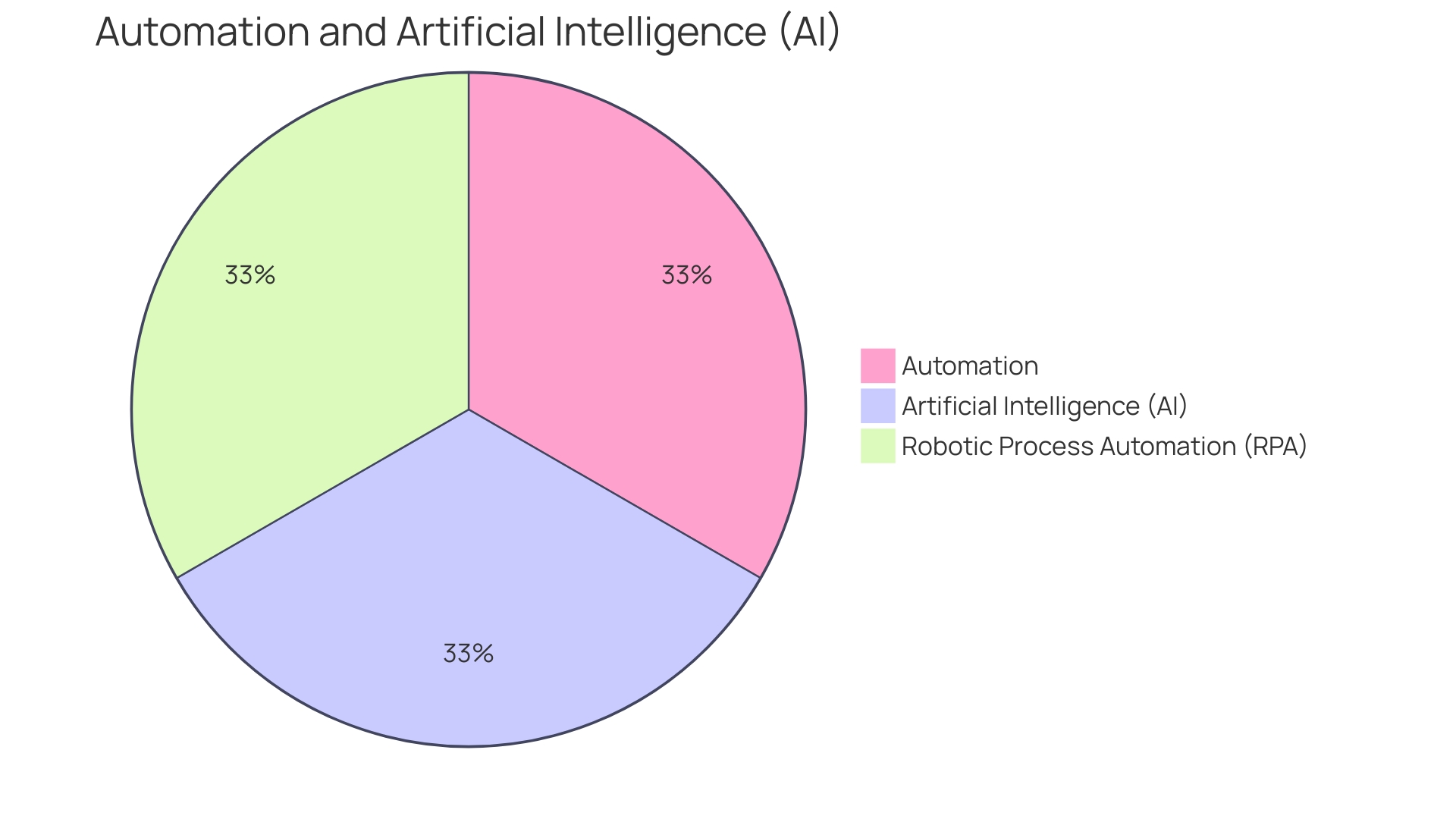
Process Assessment and Analysis
Identifying RPA opportunities is simply the initial stage; the actual work starts with a thorough evaluation and analysis of each procedure. This critical phase demands a deep dive into the intricacies of process flows, examining the inputs, outputs, and interdependencies at play. Through a detailed mapping of each step, organizations can uncover not only areas ripe for automation but also the nuances that make their operations unique.
Meta’s innovative approach to software infrastructure, including their adoption of a software monolith and open-source hardware platforms, exemplifies the significance of understanding and tackling the unique challenges that arise at scale. Through collective brainstorming, Meta addressed the ‘regionalization problem’ by sharing knowledge and establishing clear, attainable goals, demonstrating the effectiveness of collaborative problem-solving in improvement.
In the broader context, InfoQ’s Architecture and Design Trend Report highlights the shift toward more specific and targeted approaches to design, such as privacy engineering. The rise of socio-technical architecture as a trend highlights the significance of taking into account the human aspect within systems designâstressing that effective architecture is not only about the technology but also the individuals and procedures involved.
Taking this into account, leaders should address crucial inquiries before embracing robotic procedures: Which manual tasks are most amenable to RPA? What inefficiencies could RPA address? What are the investment requirements? This line of investigation is essential for differentiating between activities that are simply routine and those that could greatly gain from mechanization.
Reveille Software’s CTO and Co-Founder promotes a collaboration between technology and human oversight. This human-automation synergy is essential for stability, with monitoring and management remaining integral to the process. As companies strive for digital transformation, intelligent automation—combining RPA with AI—becomes a transformative factor, enhancing efficiency and enabling more strategic decision-making.
Building a robust library of tools to support automation technology and starting with less complex tasks are practical steps toward successful RPA implementation. Continuous monitoring and documentation of results are vital for measuring success and informing future strategies.
In the dynamic world of applications, where innovation is relentless, quality assurance teams are increasingly recognizing the value of modern testing methods. No longer seen as a mere cost center, efficient application testing is now viewed as a vital investment that can yield significant ROI and drive productivity in development and maintenance.
To navigate the complexities of software lifecycle management and maintenance, it is imperative to have a granular understanding of the market, emergent technologies, and social or economic changes that could impact the sector. Leaders must remain vigilant, frequently engaging with their dashboards and feature flags, and anticipate capacity and throughput needs well in advance. By doing so, they can ensure their organization remains agile and responsive in the face of rapid technological evolution.
Feasibility Study and ROI Calculation
Embarking on the RPA journey necessitates a meticulous evaluation to pinpoint which manual tasks are ripe for automation and to understand the underlying inefficiencies that RPA can ameliorate. Software organizations must also weigh the time and financial investment needed to integrate RPA solutions for each process. For instance, M&T Bank, with its impressive 165-year legacy, faced the digital transformation tide head-on. They established a company-wide Clean Code benchmark to enhance maintainability and performance, thereby reducing the time and expenses associated with maintenance while guaranteeing efficiency, dependability, and security.
The unyielding pace of innovation dictates that applications evolve rapidly or become obsolete. Quality assurance teams are pivotal in ensuring software functionality and quality, amid the pressures of fast-paced releases. Software testing, previously seen as a resource-draining cost center, is now recognized for its potential in yielding significant cost savings and a favorable ROI, especially when modern methodologies are adopted.
Evaluating the potential ROI of mechanization involves assessing the monetary value by comparing the time taken for manual completion against mechanization. Each factor, from the frequency of automated executions to the prediction of peak demand periods, provides valuable insights into the strategic significance of mechanization for an enterprise.
Forrester Research’s Total Economic Impact study illuminates the tangible benefits of intelligent automation, revealing a notable revenue growth of 73% in net present value and a 5.4% compound annual growth rate over three years for a composite customer. These figures underscore the critical role of RPA in driving operational excellence and financial success.
In the context of the industry in Australia, the dynamic market performance and future outlook are shaped by a myriad of factors, including technological advances and industry lifecycle stages. This confluence of factors emphasizes the importance of strategic RPA implementation in ensuring that technology organizations remain agile and competitive in an ever-evolving industry landscape.
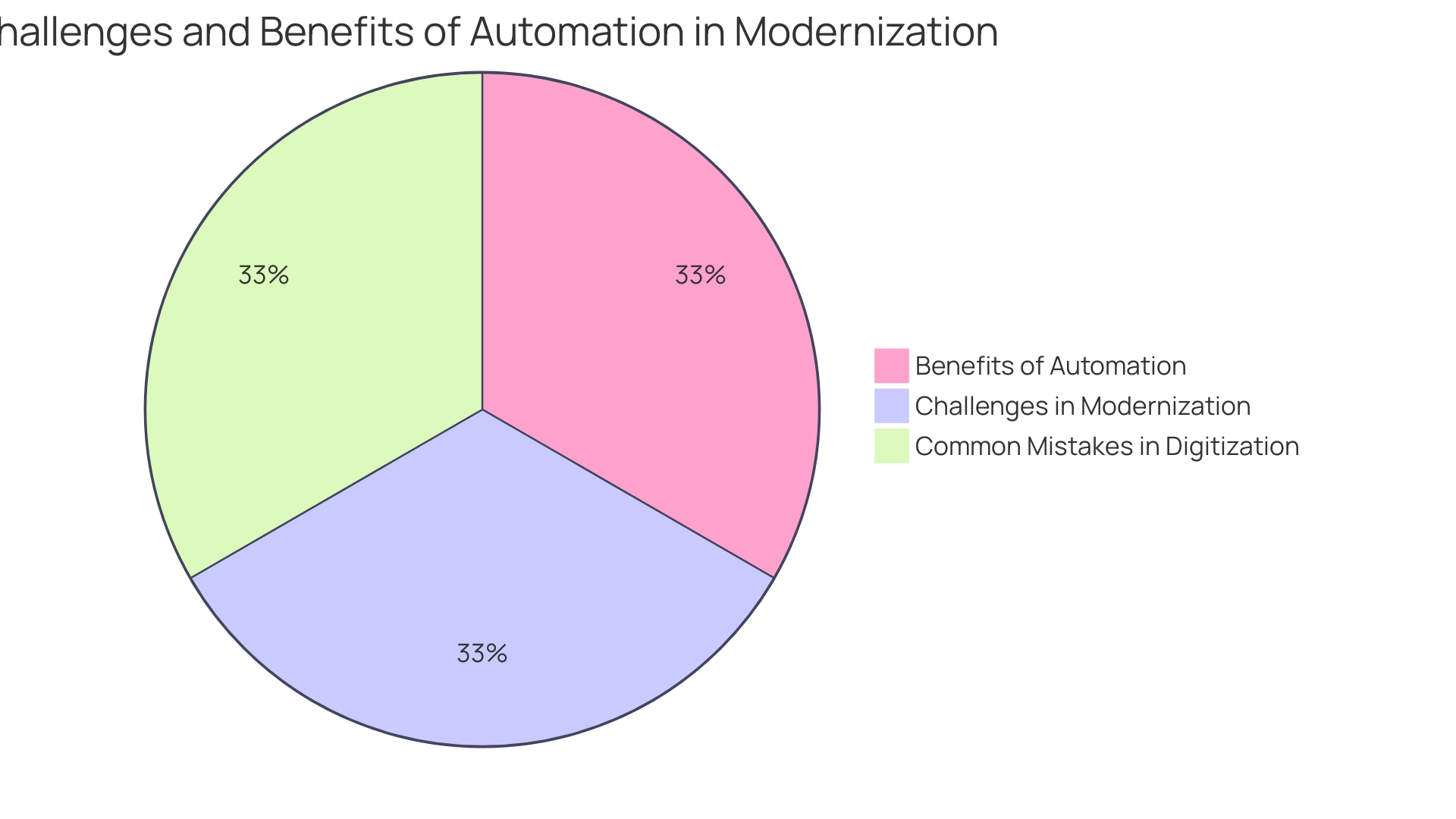
Criteria for Prioritizing Processes
Identifying which procedures to automate through RPA is a crucial stage for software organizations striving to improve operational efficiency. A successful strategy necessitates a comprehensive assessment of current manual procedures to pinpoint those that are ready for automation. Questions such as the specific inefficiencies that RPA can address, and the associated time and cost for integration, are essential to consider. Analyzing the potential return on investment is also a crucial element in prioritizing which procedures to automate. TBC Bank serves as an illustrative case, having embarked on an agile transformation to streamline its operations and reduce technical debt. Their transition to digitalization and global expansion highlights the importance of choosing the appropriate procedures for RPA to promote growth. Integrating RPA isn’t a set-and-forget solution; it demands continuous oversight and updates, much like other technological advancements throughout history. This human-machine partnership is crucial for ensuring ongoing stability and achieving the desired improvements in efficiency and productivity. In addition, for companies that develop programs, prioritizing integrations is crucial, and employing frameworks like RICE can guide them in focusing on the most impactful initiatives. Against a backdrop of high uncertainty and limited resources, start-ups, in particular, can benefit from a Start-Up Context Map. This tool assists in identifying particular engineering challenges and facilitates the decision-making for improvements. In the end, the wise choice and ranking of activities for RPA implementation can drive a software organization towards accomplishing its goals while optimizing resource allocation.
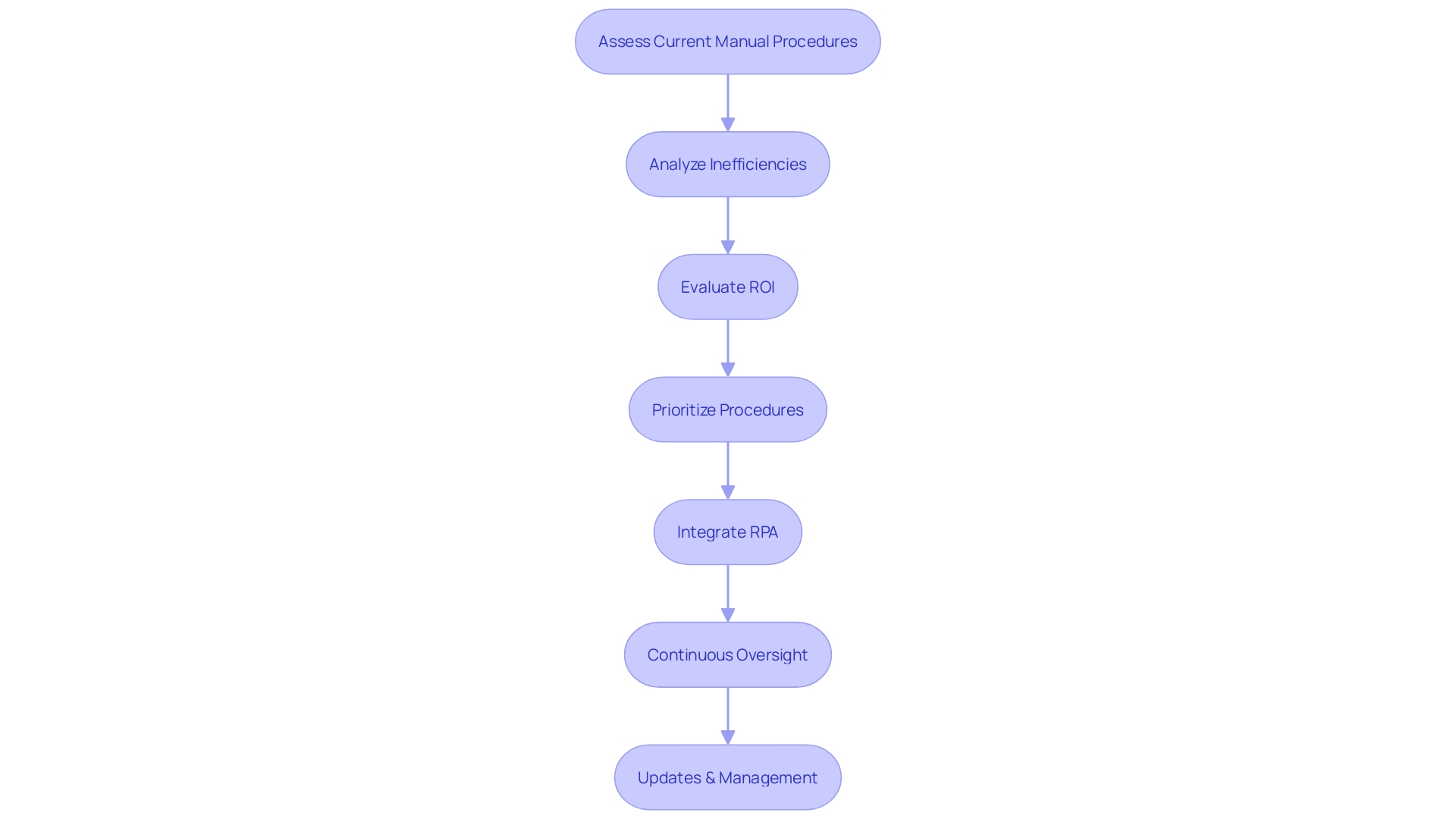
Pilot Project Selection and Proof of Concept
Embarking on the journey of Robotic Process Automation (RPA) in your organization can be transformational, but it’s important to validate its efficacy through well-executed pilot projects. These smaller initiatives offer a microcosm of your operations, allowing for a focused assessment of RPA’s impact. By choosing procedures that exemplify everyday duties, you can reveal insights into how mechanization may expand across the entire organization.
Taking inspiration from the NHS’s approach to digital technology adoption, begin by scrutinizing the security, appropriateness, and compliance of potential RPA solutions. This due diligence ensures that your chosen RPA aligns with industry standards and truly serves your organizational needs. It’s not uncommon to discover existing solutions within your own firm that could be repurposed or optimized before investing in new technologies. A rigorous initial assessment, coupled with detailed questionnaires, helps pinpoint the specific areas where RPA can deliver tangible benefits while addressing inefficiencies.
The integration of RPA should not be seen in isolation but as part of a broader strategy that balances automation with human ingenuity. The combination of digital workforces with human creativity and critical thinking can unlock unprecedented levels of productivity. As you consider which manual procedures to automate, take into account the time, costs, and potential ROI. Remember, it’s not just about automating for the sake of it; it’s about strategic modernization that elevates your operations.
In the context of the ever-evolving digital landscape, AI and cloud computing are reducing barriers to RPA adoption. They facilitate the handling of extensive data sets and optimize the digitization of assets and procedures across diverse industries. A Proof of Concept (PoC) serves as a low-risk, cost-efficient model to validate your RPA strategy, mitigating the risks associated with untested concepts and ensuring that your investment is sound and aligned with your strategic goals. By learning from the successes and challenges of others, you can approach RPA implementation with confidence and clarity, poised to reap its many benefits.
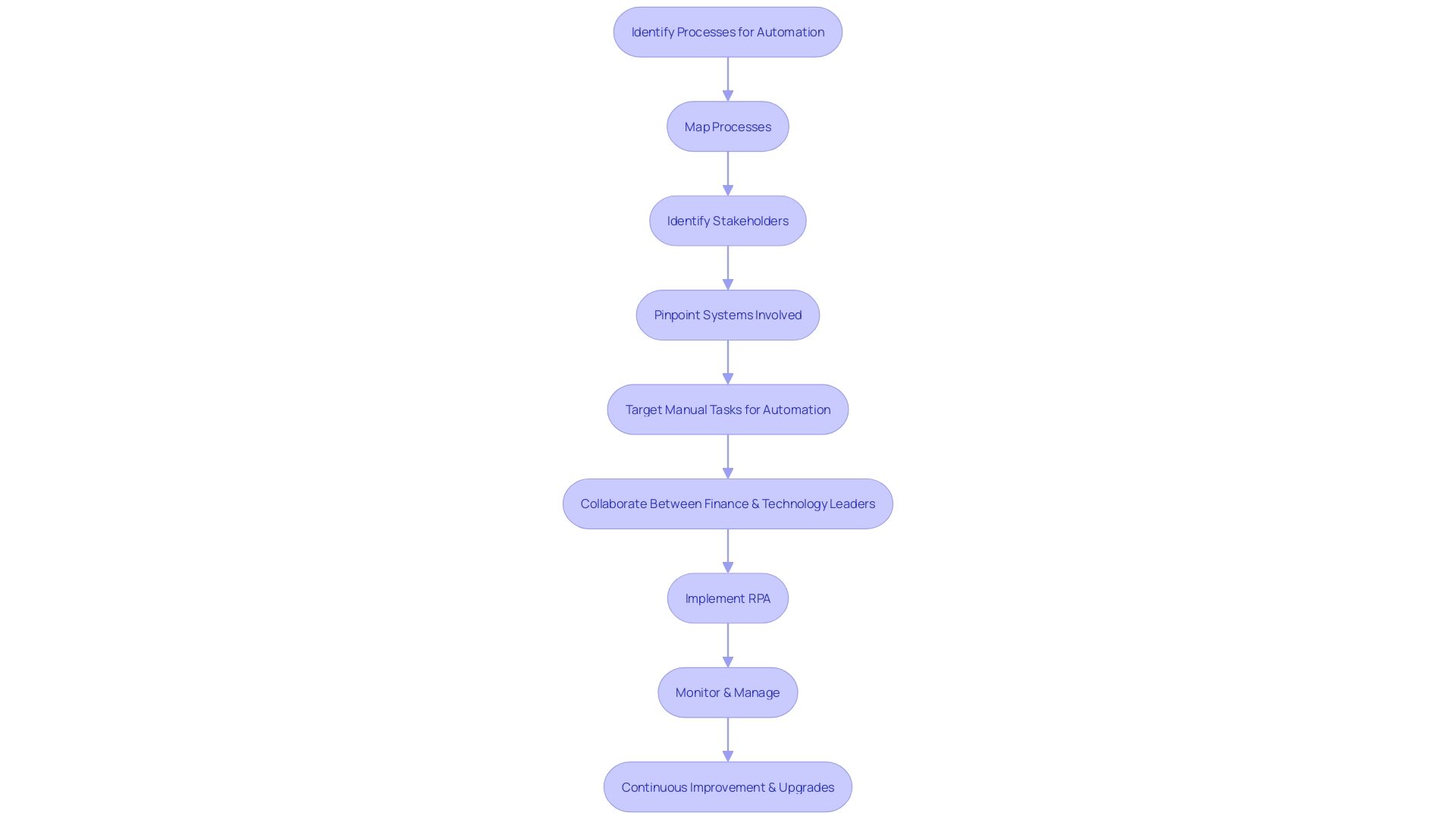
Evaluating RPA Tool Compatibility
Choosing the appropriate RPA tools for integration within the industry necessitates a strategic approach, with emphasis on factors such as integration capabilities, scalability, and security. Key questions like which manual processes should be automated and the specific inefficiencies they present are crucial to address before integration. Acknowledging the necessity for a system that upholds high-quality standards and compliance, as demonstrated by M&T Bank’s adoption of Clean Code standards, is crucial to minimize risks like security breaches and reputational harm. Moreover, the implementation of RPA must take into account the supply chain’s complexities, including the administration of open source components, as emphasized by the OSSRA report. Having an average of 526 open source components in commercial applications, automated security testing becomes essential for guaranteeing a secure and compliant environment. By thoroughly evaluating these factors, organizations can facilitate a seamless RPA implementation, aligning with the rapid digital transformation and stringent security demands of modern industries.
Preparing for RPA Implementation
To unlock the complete potential of Robotic Process Automation (RPA) in the technology sector, a strategic approach is crucial. It starts by recognizing the tasks suitable for mechanization, those that are carried out manually, repetitive, and consume a lot of time. As the technology sector evolves, integrating RPA becomes not just an option, but a necessity to stay competitive. With global enterprises allocating approximately $15 billion to generative AI solutions in 2023, the urgency to adopt RPA and similar technologies is clear.
A successful RPA implementation requires understanding its implications across the organization. This means fostering a culture of continuous learning and adaptation, essential for minimizing resistance and maximizing acceptance among the workforce. To ensure seamless integration, it’s crucial to address potential inefficiencies in processes earmarked for automation and to accurately estimate the time and financial investment required.
In addition, the emergence of AI and cloud computing has made advanced digital tools more accessible, allowing even individuals without specialized knowledge to make valuable contributions to a company’s technological capabilities. This shift underscores the importance of preparing employees for the changes that RPA will bring, including upskilling for new roles that emerge from the redefined workflows.
Businesses must also remain vigilant post-implementation, as RPA is not a ‘set-and-forget’ solution. Continuous monitoring, management, and upgrades are necessary to maintain stability and capitalize on the technology’s benefits, such as enhanced customer experience, increased revenue, and improved productivity. By setting clear timelines and success criteria, organizations can align their strategic vision with the transformative power of RPA, ensuring they are well-positioned to adapt and thrive in an increasingly automated industry landscape.
Gaining Buy-In from Stakeholders
Securing stakeholder commitment is a crucial step in the journey towards successful RPA implementation within the technology sector. This process transcends merely promoting the advantages of RPA; it requires a comprehensive understanding of the specific manual processes ripe for automation and an analysis of their current inefficiencies. By addressing potential reservations with well-researched responses, including clear ROI projections and integration timelines, leaders can pave the way for organizational alignment and secure the backing necessary for a fruitful transition.
Crucial to this endeavor is the precedent set by M&T Bank, a venerable institution in the banking industry, which embraced digital transformation amidst stringent security and regulatory demands. M&T Bank’s forward-thinking strategies included setting organization-wide Clean Code standards, thereby reinforcing the importance of high-quality, maintainable programs in a rapidly evolving technological landscape.
Further emphasizing the role of digital technologies, advancements in AI and cloud computing have drastically reduced barriers to adoption across various industries, from manufacturing to healthcare. This democratization of technology has elevated development from a support function to a core strategic asset, necessitating a strategic approach to adopting digital solutions.
In light of these industry shifts, it’s not merely about loving the technology but identifying and solving specific problems. As emphasized by experts, the focus should be on user-centric application development, starting with the user’s needs and working back towards the technology, rather than the reverse. This approach aligns with the evolving perspective on application testing, which is transitioning from a perceived cost center to a valuable investment with measurable ROI.
To achieve this goal, organizations should not only make use of the advancing technologies but also conduct comprehensive user research, prioritize simplicity, and embrace intuitive design languages. In doing so, they will not only gain stakeholder buy-in but also ensure the successful integration and utilization of RPA, delivering on its promise to enhance efficiency and drive innovation.

Addressing Potential Challenges and Overcoming Them
As the software industry navigates through digital transformation, Robotic Process Automation (RPA) promises to streamline operations, yet its integration is not without its hurdles. Important factors to consider prior to embracing RPA involve assessing which manual operations are ready for automation and identifying particular inefficiencies that automation could address. Additionally, the time and cost factors involved in integrating RPA into each process must be closely examined.
For example, M&T Bank, with its 165-year heritage, encountered the challenge of adopting Clean Code standards throughout the organization to improve program maintainability and performance amidst the all-digital shift. This reflects the broader imperative in banking to guarantee that applications uphold stringent quality and compliance standards due to the high-stakes nature of data security and transaction integrity in the industry.
In the realm of RPA, it’s not a set-and-forget system; ongoing monitoring, management, and updates are essential to maintain stability and efficiency. RPA aims to enhance productivity and accuracy while conserving time and resources, aligning with historical trends in business automation.
To facilitate a successful RPA implementation, it is crucial to engage in meaningful conversations with customers. Such interactions can yield insights into their challenges and preferences, fostering innovative solutions that resonate with users without disrupting their existing workflows. The rise of AI in development has prompted many leaders to hastily adopt AI-driven tools, often without consulting developersâhighlighting the importance of informed decision-making rooted in user experience.
Furthermore, upkeep of application programs remains a significant consideration, consuming a substantial portion of resources. A study from 1972 pointed out that application program maintenance accounted for 30.1 percent of data processing departments’ resources. This emphasizes the importance of strategic budgeting and effective lifecycle management to enhance the productivity of development and maintenance teams.
To summarize, although RPA presents persuasive advantages for the software sector, its adoption should be undertaken with a thorough comprehension of the particular workflows to streamline, the expenses and duration required, and the consistent dedication to upkeep and quality control, ensuring that any shift towards mechanization is both seamless and advantageous.

Designing an Ideal RPA Workflow
Designing the perfect workflow for Robotic Process Automation (RPA) in the software industry is akin to orchestrating a harmonious symphony between design and engineering. The design aspects focus on questioning and creating meaningful user experiences, while engineering seeks to solve technical challenges and ensure scalable, future-proof solutions. The convergence of these fields is pivotal as every modern business evolves into a technology company, integrating digital product teams to enhance human-centric digital experiences.
Before embracing RPA, it is imperative to assess the current workflow meticulously. This involves identifying manual tasks ready for robotic process optimization and identifying inefficiencies that RPA can address. Evaluating the time and cost implications of integrating RPA into these processes is also essential for a smooth transition.
The role of workflow extends beyond mere task execution; it’s about creating an ecosystem where communication is seamless and work flows effortlessly. By incorporating advanced software applications, algorithms, and rules, RPA can automate repetitive tasks, reduce human error, and bolster efficiency.
Proof of the significant influence of tools, such as AI pair-programming, is undeniable. These tools not only enhance productivity across the board but are particularly beneficial for junior developers, improving various productivity metrics such as task time, product quality, and cognitive load.
However, the path to successful RPA implementation is not without its hurdles. Amidst the enthusiasm for widespread technology transformation, a measured, incremental approach is often more effective. This approach allows for experimentation, course corrections, and scaling based on specific, achievable goals. The integration of RPA demands robust stakeholder support, adequate investment, and proficient change management.
For instance, a semiconductor foundry seeking to expedite market readiness, diminish development costs, and elevate quality embarked on a journey to standardize best practices. Through a comprehensive assessment of its R&D procedures, it established measurable goals, thereby achieving significant enhancements and advantages through digitization.
Fundamentally, creating an optimal RPA workflow in the technology industry is a strategic undertaking that necessitates a thorough comprehension of design and engineering principles, a deliberate strategy for process automation, and the acumen to confront challenges directly. By doing so, organizations can unlock unprecedented productivity gains and operational streamlining.
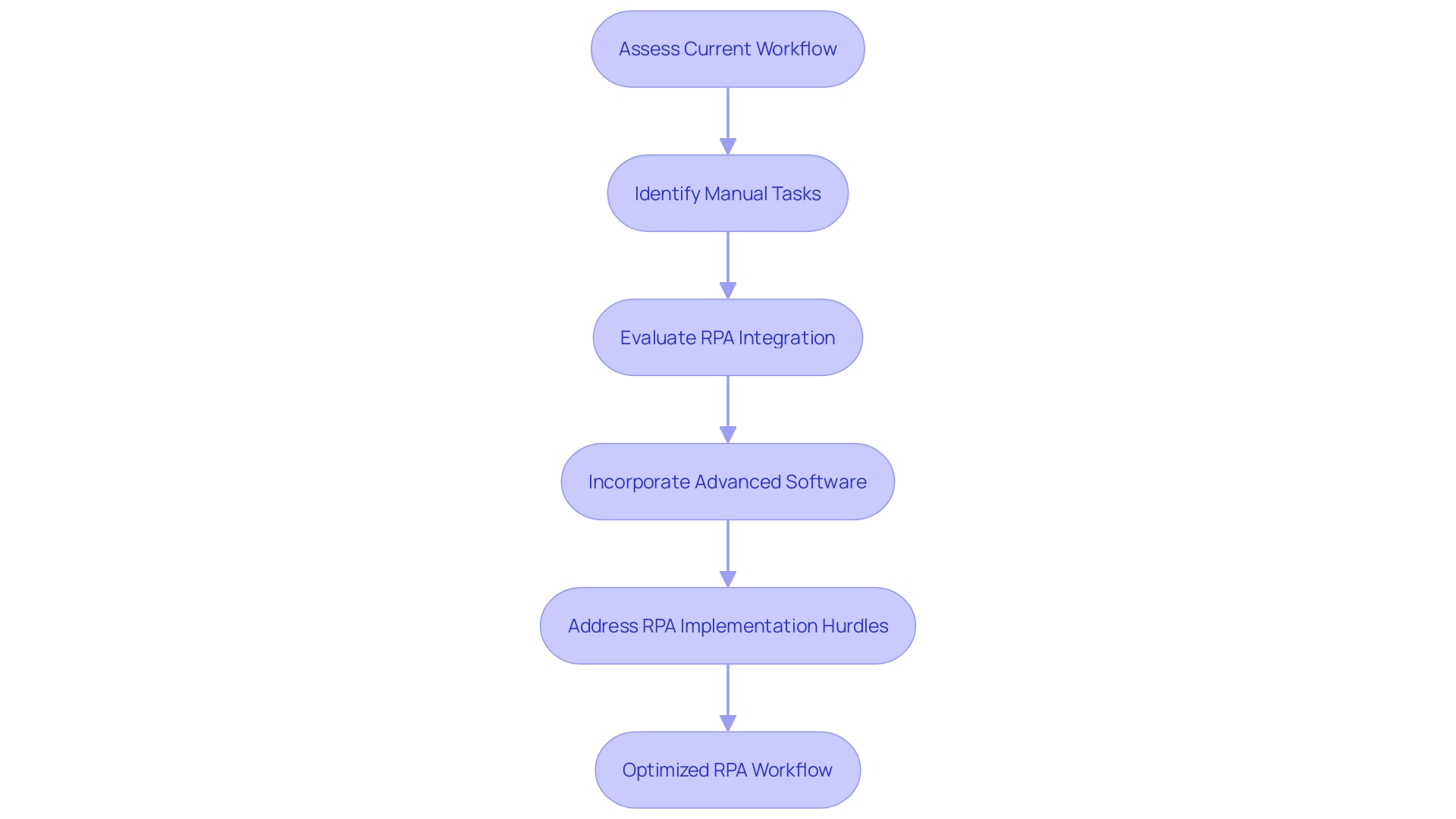
Implementing RPA: A Step-by-Step Guide
Starting the journey of Robotic Process Automation (RPA) requires a strategic alignment to ensure the industry meets the stringent demands of digital transformation. A methodical approach, beginning with a thorough analysis of which manual processes are ripe for automation, is crucial. This involves identifying inefficiencies that RPA can effectively address, along with evaluating the time and cost implications for integrating RPA solutions.
For example, M&T Bank, with its rich background and a keen focus on innovation, took on the task of maintaining high-quality coding standards crucial for banking applications. Their commitment to Clean Code principles underscores the importance of maintaining software that is not only efficient but also secure and reliable.
Meanwhile, the retail sector is showcasing the practical applications of advanced technologies, such as the checkout-free stores in Ireland utilizing Zippin technology. This illustrates the continuous development of mechanization from the water wheel to AI, which, despite its advancements, still requires human oversight for optimal operation.
Leaders in the software industry, therefore, must consider the lessons from these case studies and the broader technological landscape. By examining the State of the Automation Professional Report and understanding the experiences of automation professionals, industry leaders can better gauge the trajectory of RPA implementation and its implications on job satisfaction and career development.
As such, a structured guide to RPA implementation must encompass the initial selection of processes, development of a proof of concept, organization of resources, and meticulous testing. The pathway to successful deployment involves iterative refinement to ensure that the RPA solutions not only streamline operations but also adhere to the highest standards of quality and compliance, reflecting the lessons learned from banking to retail and beyond.

Operating and Monitoring RPA Bots
Robotic Process Automation (RPA) bots, once integrated into an organization, become crucial in streamlining operations, but their effectiveness depends on proper management and oversight. Establishing clear roles and responsibilities is essential for the upkeep of these bots, ensuring they continue to function optimally. Monitoring systems play a pivotal role as well, providing real-time insights into bot performance and swiftly pinpointing any operational issues.
For instance, Delivery Hero, operating across 70 countries with a substantial workforce, faced a recurring problem of employees being locked out of their accounts. To address this, the IT team, led by Dennis Zahrt and including talents like Slimani Ghaith and Dorina Ababii, embarked on a mission to eradicate IT bottlenecks, significantly reducing the time spent on account recovery and enhancing overall productivity.
Similarly, Rippling, supporting over 400,000 users, sought an AI agent solution that could efficiently handle complex inquiries related to HR, Payroll, and IT management. This demanded a system capable of delivering precise, timely responses, leading them away from decision-tree-based platforms towards more advanced, automated solutions.
Furthermore, the progression of mechanization from basic mechanics to advanced AI suggests that while technology has significantly enhanced efficiency and productivity, it requires ongoing collaboration with human supervision to uphold stability and adjust to upgrades, as emphasized by the CTO and Co-Founder of Reveille Software.
Recent advances in AI application within the UK’s public transport system and TSA’s facial recognition program in the US illustrate the potential of AI to enhance operational efficiency. However, these developments also raise concerns about privacy and the ethical use of technology, underscoring the importance of responsible management and observability in AI implementations.
In sum, successful RPA integration transcends mere deployment; it requires vigilant management and monitoring to ensure these digital coworkers deliver on their promise of improved operational efficiency.
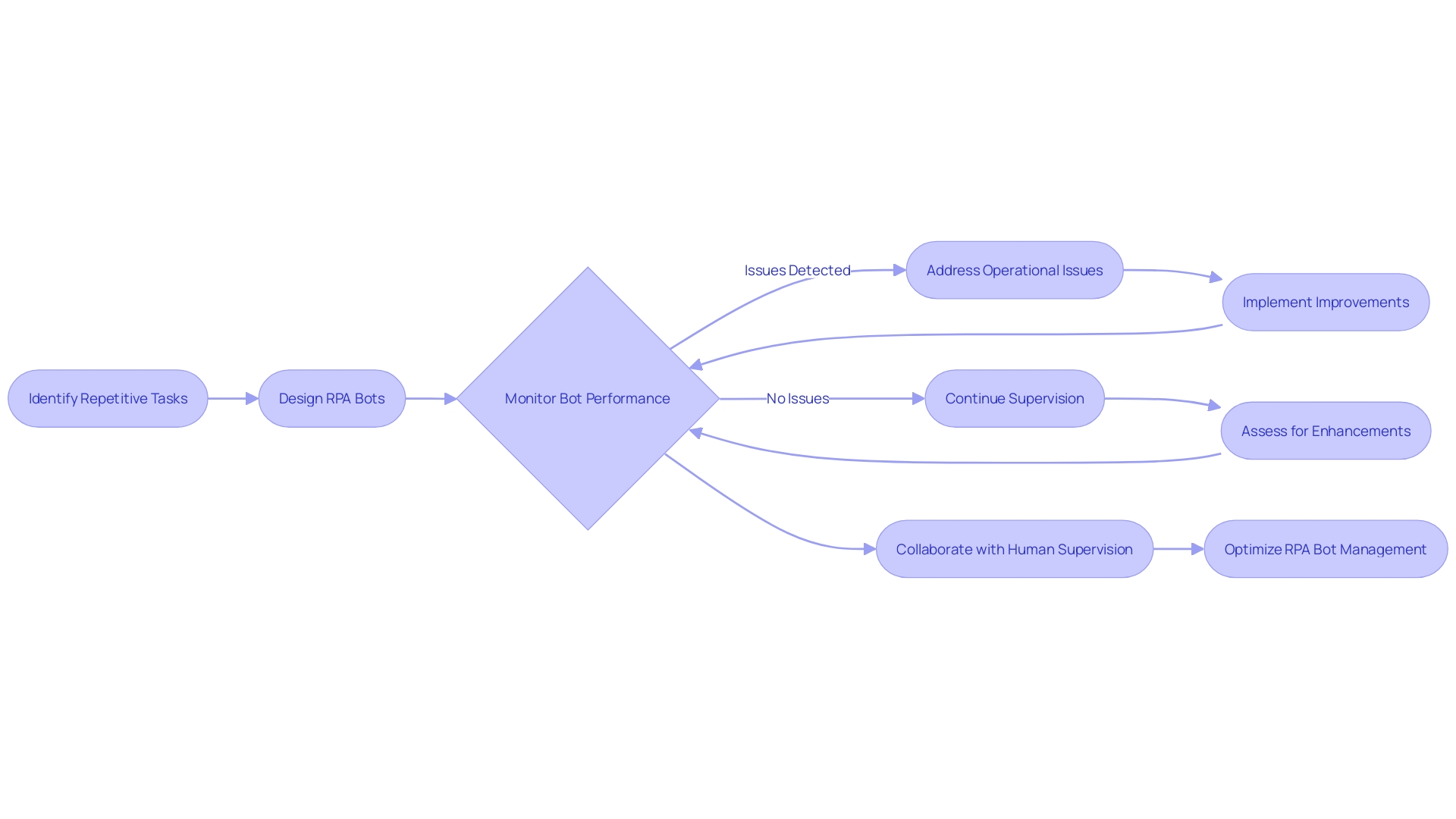
Common Challenges in RPA Implementation
When venturing into the realm of Robotic Process Automation (RPA) within the software industry, it’s imperative to navigate potential challenges with a strategic approach. A successful RPA implementation requires clear goals and the choice of activities ready for automation. It’s about inquiring about the appropriate inquiries: Which manual procedures should be automated? What inefficiencies could RPA address? What are the time and cost implications for integrating RPA into each process? M&T Bank, a respected establishment with a 165-year heritage, tackled the digital transformation directly by establishing Clean Code standards to support program maintainability and performance, ensuring their operations remained efficient, reliable, and secure. Similarly, RPA adopters must plan meticulously, choose the appropriate tools, and foster an environment conducive to change, bolstering their defenses against data breaches and upholding stringent regulatory standards. With over 27 thousand healthcare facilities globally trusting Cerner’s electronic health records system, and Epic EHR managing more than 60% of records in the U.S., the healthcare industry exemplifies the extensive reach and potential of RPA. As these technologies evolve, the insights from a global survey of 1,639 automation professionals highlight the experiences of those in the field, their transition into automation roles, and the emerging integration of AI into their work. Understanding these dynamics is a cornerstone of effective leadership in the industry’s ongoing modernization.

Measuring Success and Scalability of RPA Initiatives
For software organizations aiming to harness the power of Robotic Process Automation (RPA), it’s essential to go beyond just deployment and delve into the measurement of success and scalability. This necessitates the establishment of a robust framework for tracking and analyzing the performance of RPA initiatives, which involves tailoring key performance indicators (KPIs) to reflect the company’s strategic objectives. By doing so, firms can leverage these insights to inform decisions, refine their RPA strategies, and enhance operational efficiency.
To illustrate, consider the case of Lindy, an AI assistant designed to automate a complex array of tasks. Lindy’s success depended on integrating a multitude of applications and services. By tracking and refining performance metrics, the integration enabled AI assistants to efficiently carry out tasks, which would have been impossible without it. Similarly, Delivery Hero tackled the challenge of employee account lockouts by automating the recovery process, reducing the time spent on each request from 35 minutes to a near-instant solution, significantly improving operational efficiency.
These examples demonstrate the transformative impact of RPA when paired with diligent monitoring and continuous improvement. By adopting this approach, technology companies can ensure that their RPA initiatives are not only successful but also scalable, adapting to the evolving needs of the business and maintaining a competitive edge in the dynamic tech landscape.
Future Trends and Innovations in RPA
As the field of Robotic Process Automation (RPA) continues to thrive, it is crucial for software organizations to actively embrace emerging technologies like cognitive computing and machine learning to maintain a competitive edge. These advancements synergize with RPA, paving the way for transformative operational efficiency and innovation.
Before implementing mechanization, it’s crucial to carry out a comprehensive examination to recognize procedures suitable for RPA incorporation. Questions like which manual tasks are most suitable for automation and what inefficiencies RPA can address can guide organizations in making strategic decisions. This analytical approach also helps in evaluating the potential return-on-investment and assessing how well RPA solutions can integrate with existing digital infrastructures.
The landscape of business is increasingly characterized by the integration of human and digital labor, creating a collaborative ecosystem where both elements enhance each other’s capabilities. It’s not merely about automating tasks but also about establishing a balance that leverages human creativity and Ai’s efficiency. As the market for AI continues to expand, with projections reaching $305.90 billion by 2024 and a growth rate of 15.83% from 2024 to 2030, the significance of RPA in the AI-driven business environment becomes even more pronounced.
Leaders in the technology industry must consider continuous improvement and hyper automation as part of a strategic journey, ensuring that developments in AI and RPA are not only adopted but also continuously optimized. This dedication to progress is essential for unleashing the complete potential of an AI-empowered workforce, optimizing procedures, and ultimately shaping the future of work.
In essence, to capitalize on RPA and its associated technologies, software organizations must engage in careful planning, invest in the right tools, upskill their workforce, and commit to ongoing refinement of their processes. By doing so, they can ensure that they not only keep pace with but also lead the way in the rapidly advancing field of automation.
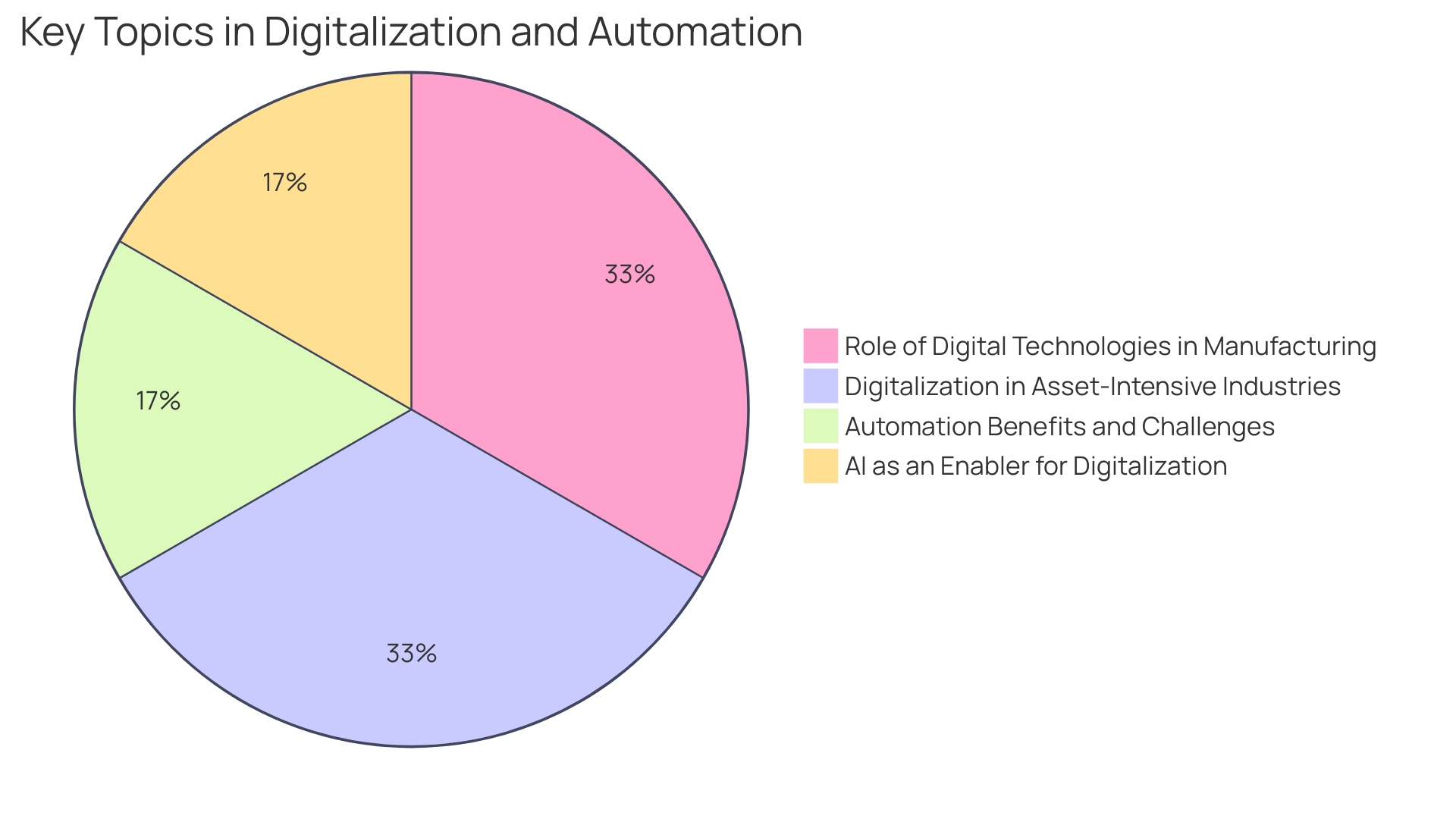
Conclusion
In conclusion, implementing RPA in the software industry is a strategic solution for enhancing operational efficiency and staying competitive. By identifying automation opportunities, assessing processes, and conducting feasibility studies, organizations can streamline operations and improve accuracy. Selecting the right RPA tools, preparing for implementation, and gaining stakeholder buy-in are crucial steps.
Addressing potential challenges and measuring success through performance tracking and refinement are essential. Embracing emerging technologies ensures a competitive edge and future readiness. Overall, RPA empowers software organizations to optimize their processes, enhance efficiency, and thrive in the digital ecosystem.
Ready to streamline your operations and improve accuracy? Learn more about our RPA solutions.

